Optimal Operation Analysis of the Distribution Network Comprising a Micro Energy Grid Based on an Improved Grey Wolf Optimization Algorithm
Abstract
:Featured Application
Abstract
1. Introduction
2. Operating Structure of a Distribution Network Comprising a Micro Energy Grid
3. Bi-Level Optimal Model of a Distribution Network Comprising a Micro Energy Grid
3.1. Optimal Model of the Distribution Network
3.1.1. Objective Function
3.1.2. Constraint Conditions
3.1.3. Processing Method for Transforming the Multi-Objective Model into a Single-Objective Model
3.2. Optimal Micro-Energy-Grid Model
3.2.1. Objective Function
3.2.2. Constraint Conditions
4. GWO Algorithm Based on the Dynamic Adjustment of the Proportional Weight and Convergence Factor
4.1. Improved GWO Algorithm
4.2. Verification of the Superiority of the Improved GWO Algorithm
5. Example Analysis
5.1. Overview of the Simulation System
5.2. Analysis of the Simulation Results
5.2.1. Active Power Loss Analysis of the Distribution Network Comprising the Micro Energy Grid
5.2.2. Voltage Deviation Analysis of the Distribution Network Comprising the Micro Energy Grid
5.2.3. Optimal Dispatching Scheme of the Upper Distribution-Network Level
5.2.4. Optimal Dispatching Scheme of the Lower Micro-Energy-Grid Level
5.2.5. Performance Comparison of the Improved GWO Algorithm with the GWO, GWO-EPD, IWO, and PSO Algorithms
5.2.6. Daily Cost Analysis of the Distribution Network Comprising the Micro Energy Grid Using the Improved GWO Algorithm, the GWO Algorithm, the GWO-EPD Algorithm, the IWO Algorithm, and the PSO Algorithm
5.2.7. Weight Sensitivity Analysis of the Objective Function of the Upper Distribution Network
6. Conclusions
Author Contributions
Acknowledgments
Conflicts of Interest
Nomenclature
| Variables | |
| cost of waste-to-energy power | |
| electrical power of waste-to-energy power | |
| electrical load of the distribution network | |
| exchanged electrical power between the micro energy grid and distribution network | |
| convergence factors | |
| electrical power of the air-source heat pump in exchanging cooling or heating power | |
| electrical power of wind power | |
| exchanged cooling power of the air-source heat pump | |
| cooling power of the lithium-bromide absorption-type refrigerator | |
| charging or discharging cooling power of the cooling storage tank | |
| electrical power of PV | |
| exchanged heating power of the air-source heat pump | |
| heating power of the heat-recovery boiler | |
| price of purchasing electricity for the micro energy grid | |
| voltage of node | |
| convergence factors | |
| voltage deviation of the distribution network | |
| rated value of the nodal voltage | |
| active power loss of the distribution network | |
| swing factors | |
| electrical power of the microturbine | |
| equipment maintenance cost of micro-source x | |
| fuel cost of micro-source x | |
| initial fixed investment cost of micro-source x | |
| charging or discharging electrical power of the battery storage | |
| electrical power of micro-source x | |
| heating power of the gas-fired boiler | |
| charging or discharging heating power of the heating storage tank | |
| price of selling electricity for the micro energy grid | |
| Abbreviations | |
| PSO | particle swarm optimization |
| IWO | invasive weed optimization |
| GWO | grey wolf optimization |
| GWO-EPD | grey wolf optimization/evolutionary population dynamics |
Appendix A
| Branch | Node | R (p.u.) | X (p.u.) | |
|---|---|---|---|---|
| From | To | |||
| 1 | 0 | 1 | 0.491 | 0.295 |
| 2 | 1 | 2 | 0.104 | 0.137 |
| 3 | 2 | 3 | 0.104 | 0.135 |
| 4 | 3 | 4 | 0.126 | 0.167 |
| 5 | 4 | 5 | 0.033 | 0.042 |
| 6 | 5 | 6 | 0.223 | 0.294 |
| 7 | 6 | 7 | 0.198 | 0.261 |
| 8 | 7 | 8 | 0.124 | 0.163 |
| 9 | 8 | 9 | 0.229 | 0.221 |
| 10 | 9 | 10 | 0.231 | 0.226 |
| 11 | 10 | 11 | 0.307 | 0.215 |
| 12 | 11 | 12 | 0.195 | 0.059 |
| 13 | 1 | 13 | 0.491 | 0.295 |
| 14 | 2 | 14 | 0.135 | 0.058 |
| 15 | 3 | 15 | 0.271 | 0.116 |
| 16 | 4 | 16 | 0.272 | 0.113 |
| 17 | 5 | 17 | 0.269 | 0.223 |
| 18 | 6 | 18 | 0.198 | 0.085 |
| 19 | 18 | 19 | 0.198 | 0.085 |
| 20 | 18 | 20 | 0.792 | 0.341 |
| 21 | 7 | 21 | 0.099 | 0.043 |
| 22 | 21 | 22 | 0.098 | 0.042 |
| 23 | 22 | 23 | 0.096 | 0.049 |
| 24 | 23 | 24 | 0.961 | 0.391 |
| 25 | 8 | 25 | 0.333 | 0.152 |
| 26 | 25 | 26 | 0.267 | 0.125 |
| 27 | 25 | 27 | 0.083 | 0.037 |
| 28 | 10 | 28 | 0.352 | 0.217 |
| 29 | 28 | 29 | 0.301 | 0.152 |
References
- Yun, H.B.; Zhang, C.; Deng, Z.Q.; Bian, H.F.; Sun, C.G.; Jia, C. Economic optimization for configuration and sizing of micro integrated energy systems. J. Mod. Power Syst. Clean Energy 2018, 6, 330–341. [Google Scholar]
- Mohammadi, A.; Mehrtash, M.; Kargarian, A. Diagonal quadratic approximation for decentralized collaborative TSO+DSO optimal power flow. IEEE Trans. Smart Grid 2018, (in press). [Google Scholar] [CrossRef]
- Bahrami, S.; Amini, M.H. A decentralized trading algorithm for an electricity market with generation uncertainty. Appl. Energy 2018, 218, 520–532. [Google Scholar] [CrossRef] [Green Version]
- Stephen, C.; Pierluigi, M. Integrated electricity-heat-gas modeling and assessment, with applications to the Great Britain system. Part I: High-resolution spatial and Temporal heat demand modeling. Energy 2018, (in press). [Google Scholar] [CrossRef]
- Solanki, B.V.; Raghurajan, A.; Bhattacharya, K.; Canizares, C.A. Including smart loads for optimal demand response in integrated energy management systems for isolated microgrids. IEEE Trans. Smart Grid 2017, 8, 1739–1748. [Google Scholar] [CrossRef]
- Ojeda-esteybrd, M.; Rubio-barrosrg, R.; Vargasa, A. Integrated operation planning of hydrothermal power and natural gas systems with large scale storages. J. Mod. Power Syst. Clean Energy 2017, 5, 299–313. [Google Scholar] [CrossRef]
- Xu, Q.S.; Zeng, A.I.; Wang, K. Day-ahead optimized economic dispatching for combined cooling, heating and power in micro energy-grid based on hessian interior point method. Power Syst. Technol. 2016, 40, 1657–1665. [Google Scholar]
- Golden Concord Group Limited’s Multi-Complementary Project Is Selected as National Demonstration Project. Available online: http://paper.people.com.cn/zgnyb/html/2017-02/13/content_1750009.htm (accessed on 13 February 2017).
- Determined to Forge Ahead, High-tech Blueprint. Available online: http://jsnews.jschina.com.cn/shms/201709/t20170907_1017177.shtml (accessed on 7 September 2017).
- Napis, N.F.; Abd.kadir, A.F.; Khatib, T.; Hassan, E.E.; Sulaima, M.F. An improved method for reconfiguring and optimizing electrical active distribution network using evolutionary particle swarm optimization. Appl. Sci. 2018, 8, 804. [Google Scholar] [CrossRef]
- Li, X.L.; Geng, G.F.; Ji, Y.Q.; Lu, L.Z. Operation strategy of battery energy storage system in distribution network with distributed generation. Power Autom. Equip. 2017, 37, 1–6. [Google Scholar]
- Wang, Y.; Chen, M.; Zhang, M.; Ji, W.L.; Sun, X.J.; Luo, X.; Lan, L.; Gu, W. Distributed reactive power optimization for active distribution network based on equal incremental rate of network loss. Power Syst. Technol. 2017, 41, 1–9. [Google Scholar]
- Fu, Y.; Liao, J.B.; Li, Z.K.; Qian, X.; Tang, X. Day-ahead optimal scheduling and operating of active distribution network considering violation risk. Proc. CSEE 2017, 37, 1–11. [Google Scholar]
- Arshad, A.; Ekstrom, J.; Lehtonen, M. Multi-agent based distributed voltage regulation scheme with grid-tied inverters in active distribution networks. Electr. Power Syst. Res. 2018, 160, 180–190. [Google Scholar] [CrossRef]
- Wang, W.; Huang, D.W. The coordination optimization of distribution networks with dispatched distributed generators. Trans. CES 2015, 30, 429–433. [Google Scholar]
- Shukla, J.; Das, B.; Pant, V. Stability constrained optimal distribution system reconfiguration Uncertainties in correlated loads and distributed generations. Int. J. Electr. Power Energy Syst. 2018, 99, 121–133. [Google Scholar] [CrossRef]
- Wang, L.; Sharkh, S.; Chipperfield, A. Optimal decentralized coordination of electric vehicles and renewable generators in a distribution network using A* search. Int. J. Electr. Power Energy Syst. 2018, 98, 474–487. [Google Scholar] [CrossRef]
- Sheikhi, A.; Rayati, M.; Bahrami, S.; Ranjbar, A.M.; Sattari, S. A cloud computing framework on demand side management game in smart energy hubs. Int. J. Electr. Power Energy Syst. 2015, 64, 1007–1016. [Google Scholar] [CrossRef]
- Amini, M.H.; Nabi, B.; Haghifam, M. Load management using multi-agent systems in smart distribution network. In Proceedings of the IEEE Power and Energy Society General Meeting, Vancouver, BC, Canada, 21–25 July 2013; pp. 1–5. [Google Scholar]
- Li, C.B.; Zhang, J.Y.; Li, P. Multi-objective optimization model of micro-grid operation considering cost, pollution discharge and risk. Proc. CSEE 2015, 35, 1051–1058. [Google Scholar]
- Huh, J.H.; Seo, K. Hybrid advanced metering infrastructure design for micro grid using the game theory model. Int. J. Softw. Eng. Appl. 2015, 9, 257–268. [Google Scholar] [CrossRef]
- Yang, Y.; Lei, X.; Ye, T.; Li, T.; Xu, G.Y. Microgrid energy optimal dispatch considering the security and reliability. Proc. CSEE 2014, 34, 3080–3088. [Google Scholar]
- Zhao, H.R.; Wu, Q.W.; Wang, C.S.; Cheng, L.; Rasmussen, C.N. Fuzzy logic based coordinated control of battery energy storage system and dispatchable distributed generation for microgrid. J. Mod. Power Syst. Clean Energy 2015, 3, 422–428. [Google Scholar] [CrossRef] [Green Version]
- Armedariz, M.; Heleno, M.; Cardoso, G.; Mashayekh, S.; Stadler, M.; Nordstrom, L. Coordinated microgrid investment and planning process considering the system operator. Appl. Energy 2017, 200, 132–140. [Google Scholar] [CrossRef] [Green Version]
- Xu, Y.T.; Ai, Q. Coordinated optimal dispatch of active distribution network with microgrids. Power Autom. Equip. 2013, 41, 143–149. [Google Scholar]
- Fathi, M.; Bevrani, H. Statistical Cooperative Power Dispatching in Interconnected Microgrids. IEEE Trans. Sustain. Energy 2013, 4, 586–593. [Google Scholar] [CrossRef]
- Wang, Z.Y.; Wang, J.H. Self-healing resilient distribution systems based on sectionalization into microgrids. IEEE Trans. Power Syst. 2015, 30, 3139–3149. [Google Scholar] [CrossRef]
- Haddadian, H.; Noroozion, R. Optimal operation of active distribution systems based on microgrid structure. Renew. Energy 2017, 104, 197–210. [Google Scholar] [CrossRef]
- Ameli, A.; Bahrami, S.; Khazaeli, F.; Haghifam, M. A multiobjective particle swarm optimization for sizing and placement of DGs from DG owner’s and distribution company’s viewpoints. IEEE Trans. Power Deliv. 2014, 29, 1831–1840. [Google Scholar] [CrossRef]
- Mirjalili, S.; Mirjalili, S.M.; Lewis, A. Grey wolf optimizer. Adv. Eng. Softw. 2014, 69, 46–61. [Google Scholar] [CrossRef]
- Jayakumar, N.; Subramanian, S.; Ganesan, S.; Elanchezhian, E.B. Grey wolf optimization for combined heat and power dispatch with cogeneration systems. Int. J. Electr. Power Energy Syst. 2016, 74, 252–264. [Google Scholar] [CrossRef]
- Precup, R.E.; Davic, R.C.; Petriu, E.M. Grey wolf optimizer algorithm-based tuning of fuzzy control systems with reduced parametric sensitivity. IEEE Trans. Ind. Electron. 2017, 64, 527–534. [Google Scholar] [CrossRef]
- Xiong, X.; Wang, J.B.; Jing, T.J.; Yang, R.G.; Ye, L. Power optimization control of microgrid cluster. Power Autom. Equip. 2017, 37, 10–17. [Google Scholar]
- Zhao, X.; Zhao, C.Y.; Jia, X.F.; Li, G.Y. Fuzzy synthetic evaluation of power quality based on changeable weight. Power Syst. Technol. 2005, 29, 11–16. [Google Scholar]
- Vascak, J. Adaptation of fuzzy cognitive maps by migration algorithms. Kybernetes 2012, 41, 429–443. [Google Scholar] [CrossRef]
- Precup, R.E.; Sabau, M.C.; Petriu, E.M. Nature-inspired optimal tuning of input membership functions of takagi-sugeno-kang fuzzy models for anti-lock braking systems. Appl. Soft Comput. 2015, 27, 575–589. [Google Scholar] [CrossRef]
- Ali, M.Z.; Awad, N.H.; Duwairi, R.M. Multi-objective differential evolution algorithm with a new improved mutation strategy. Int. J. Artif. Intell. 2016, 14, 23–41. [Google Scholar]
- Chen, Z.M.; Zhou, S.R.; Luo, J.T. A robust ant colony optimization for continuous functions. Expert Syst. Appl. 2017, 81, 309–320. [Google Scholar] [CrossRef]
- Castillo, C.A.; Conde, A.; Shih, M.Y. Improvement of non-standardized directional overcurrent relay coordination by invasive weed optimization. Electr. Power Syst. Res. 2018, 157, 48–58. [Google Scholar] [CrossRef]
- Saremi, S.; Mirjalili, S.Z.; Mirjalili, S.M. Evolutionary population dynamics and grey wolf optimizer. Neural Comput. Appl. 2015, 26, 1257–1263. [Google Scholar] [CrossRef]
- Ma, X.Y.; Wu, Y.W.; Fang, H.L.; Sun, Y.Z. Optimal sizing of hybrid solar-wind distributed generation in an islanded microgrid using improved bacterial foraging algorithm. Proc. CSEE 2011, 31, 17–25. [Google Scholar]
- Xian, X.; Fan, C.G.; Wen, S.S.; Wang, Y.C.; Chen, C.; Liu, X. Optimal deployment for island microgrid considering probabilistic factors of renewable energy generations. Eng. J. Wuhan Univ. 2016, 49, 101–104. [Google Scholar]
- Pazouki, S.; Haghifam, M.R.; Moser, A. Uncertainty modeling in optimal operation of energy hub in presence of wind, storage and demand response. Int. J. Electr. Power Energy Syst. 2014, 61, 335–345. [Google Scholar] [CrossRef]
- Yang, L.; Sun, Z.L.; Yin, M.A.; Wang, Y.N. Optimization design of cartridge pressing structure for feed mechanism based on the sensitivity analysis of multi-attribute decision making. Acta Armamentarii 2014, 35, 241–247. [Google Scholar]
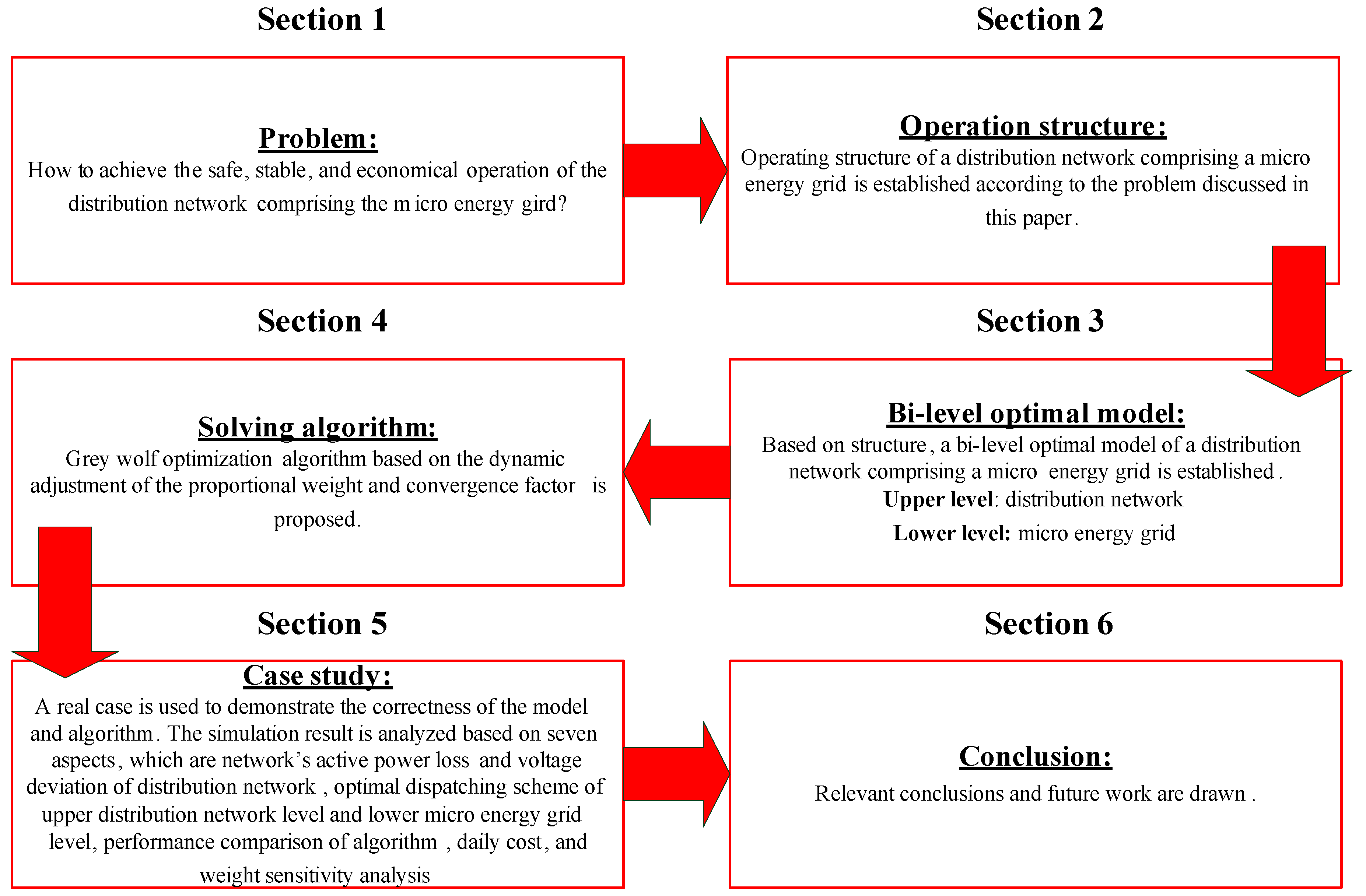

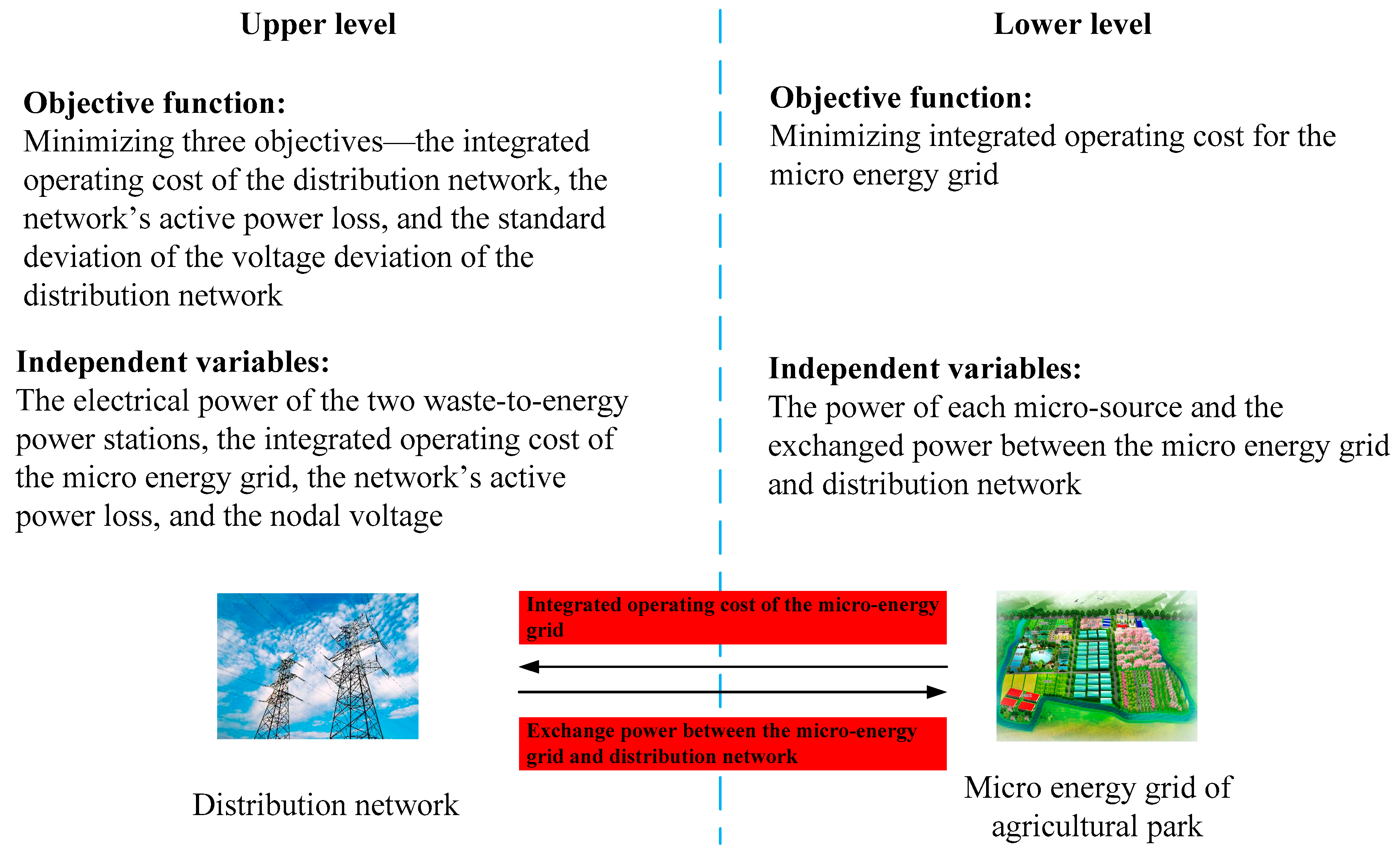
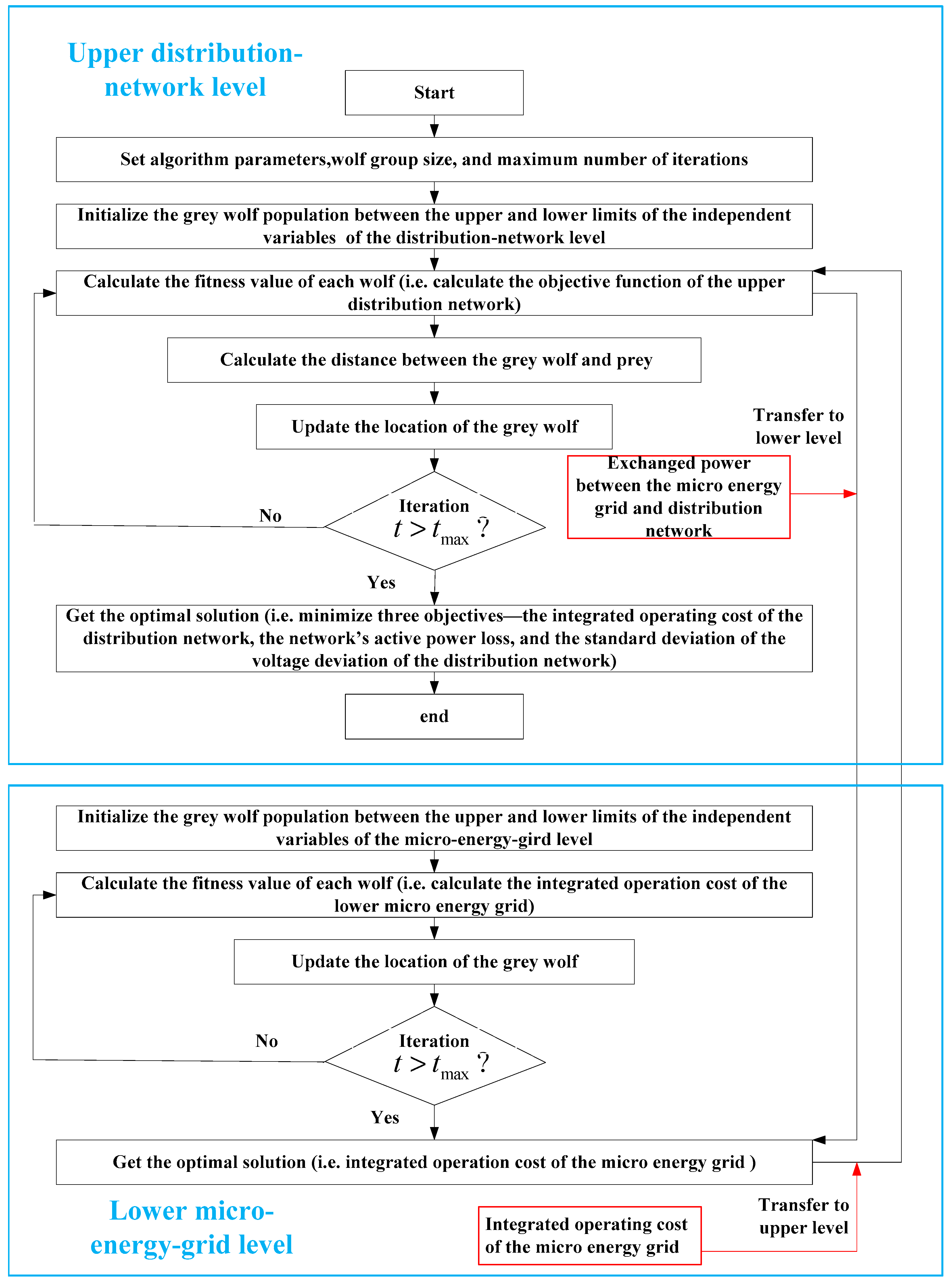
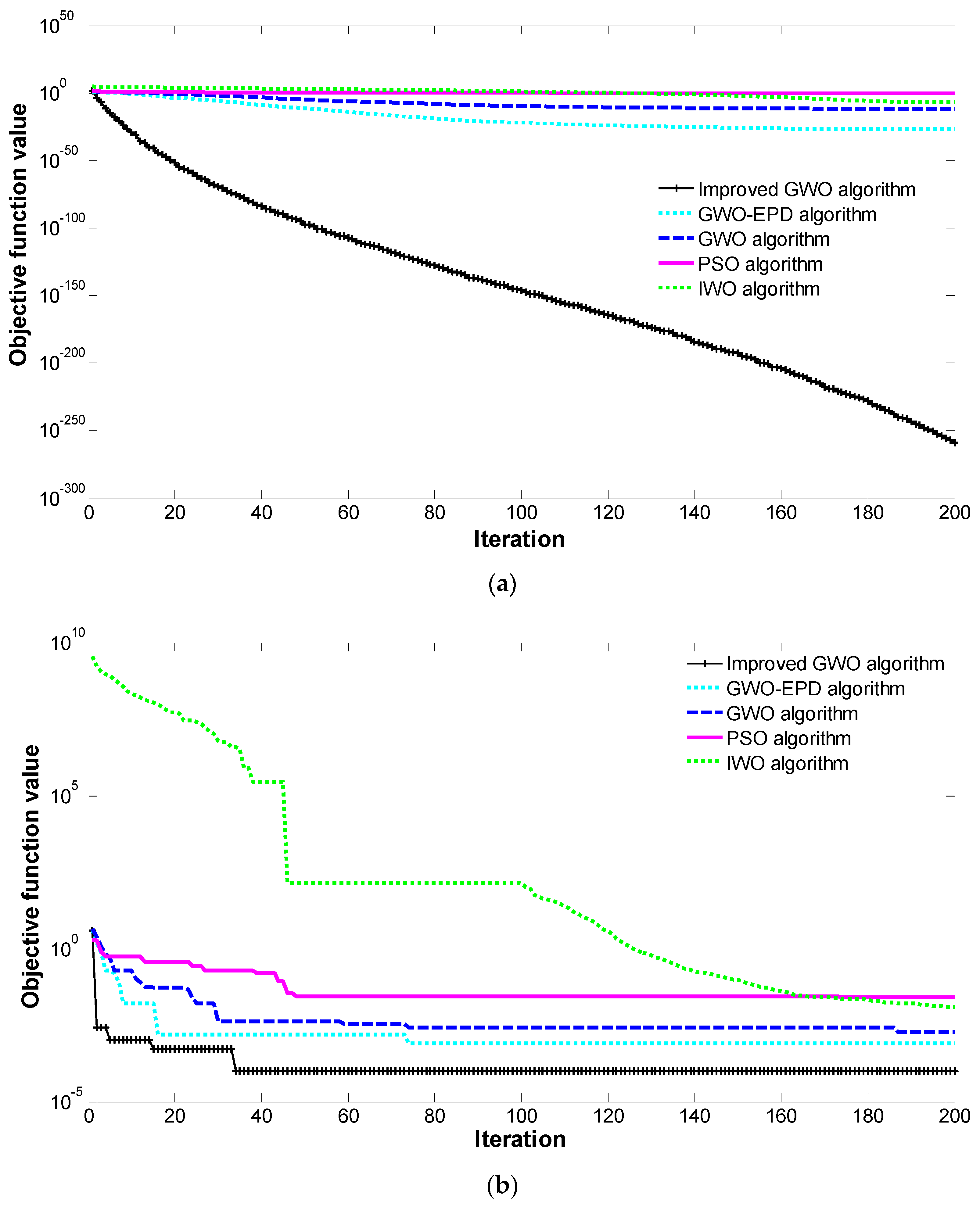

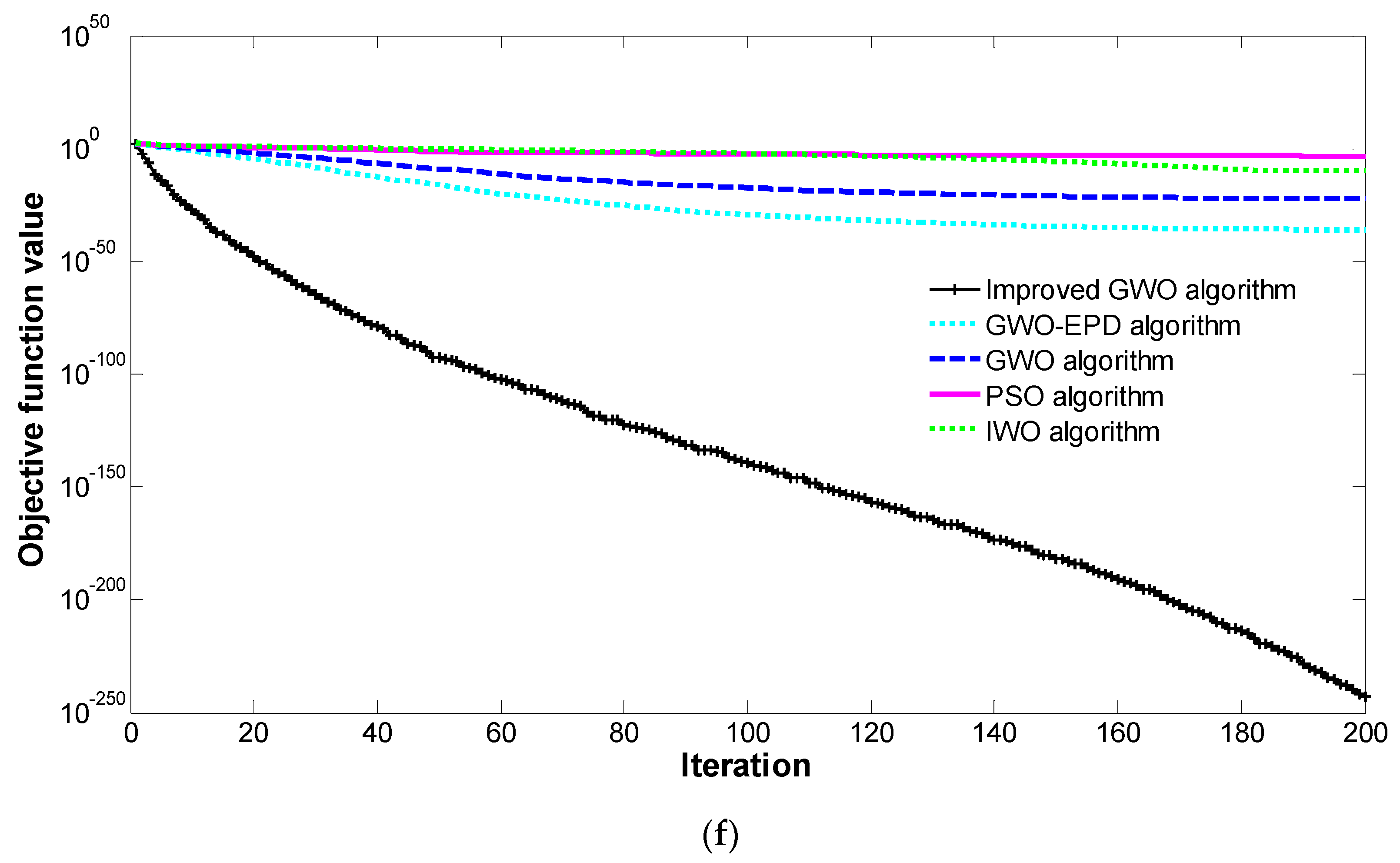


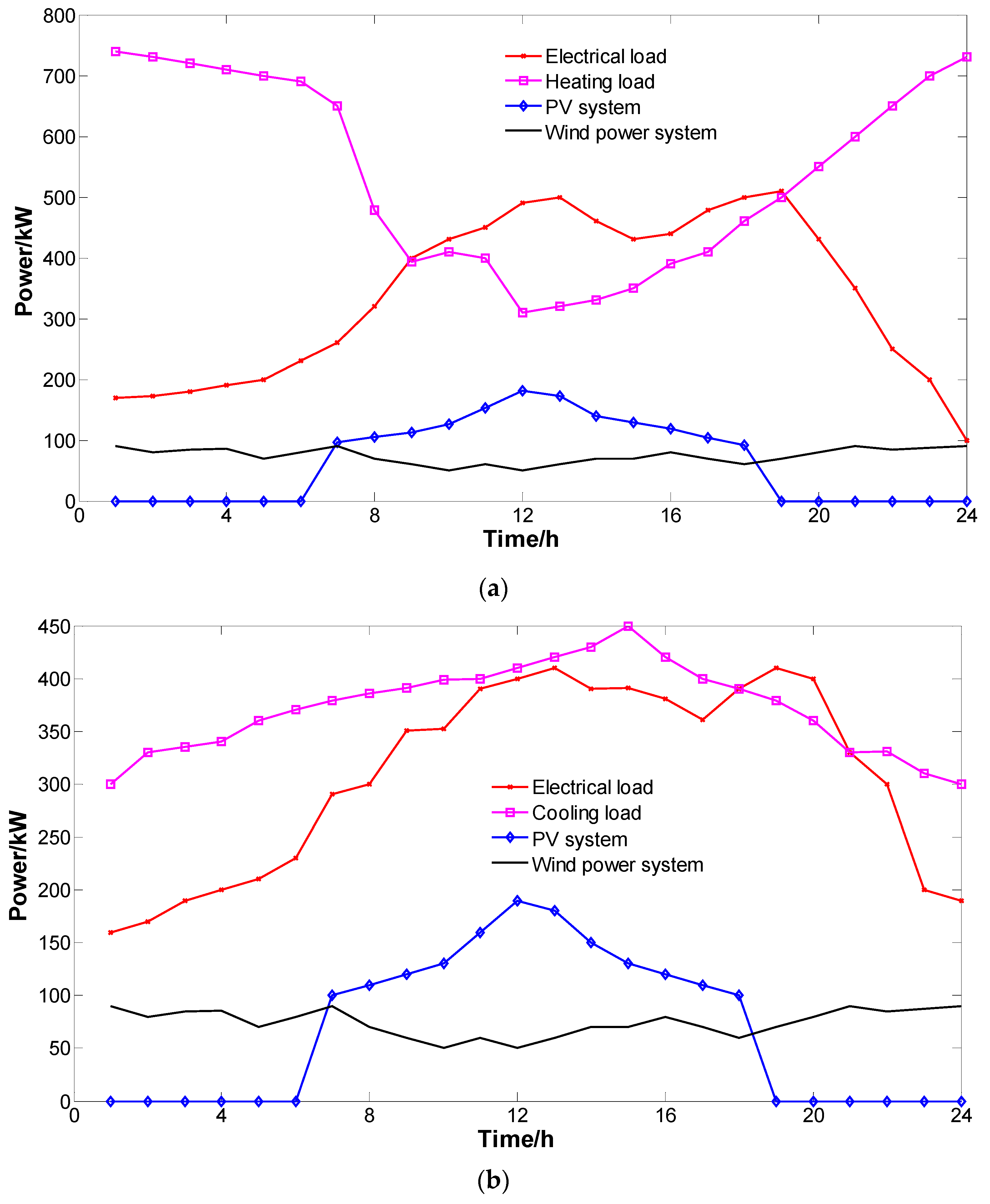
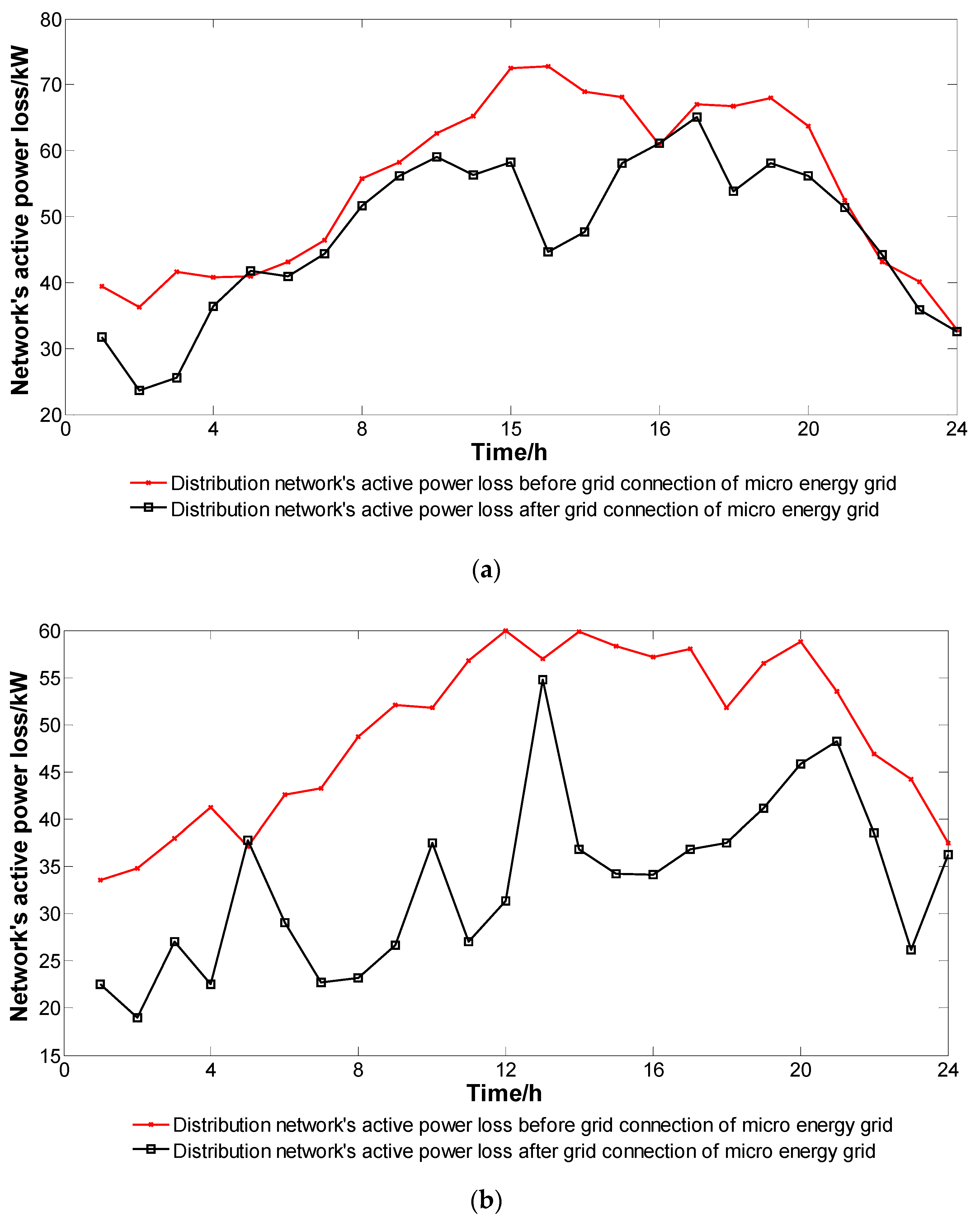
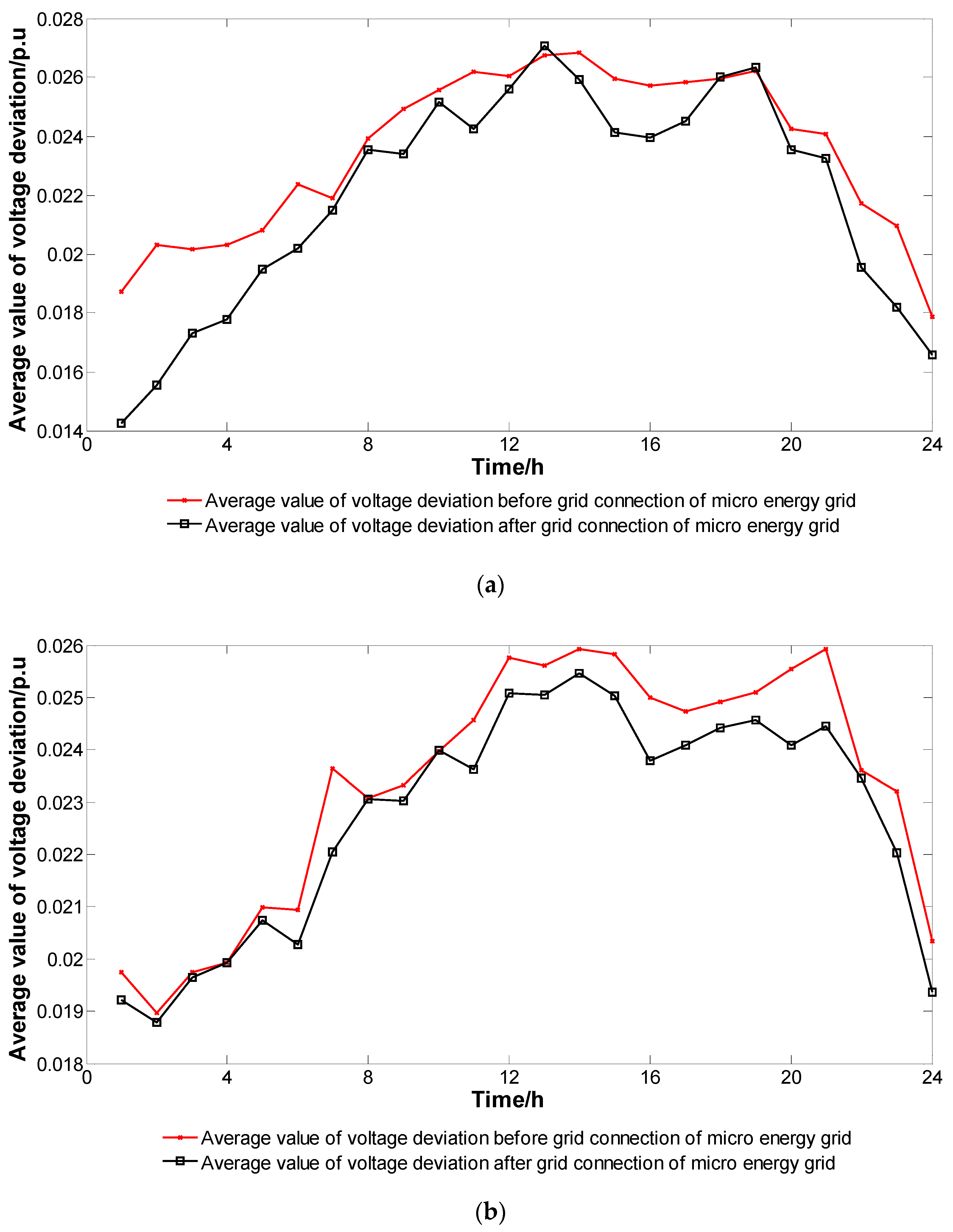
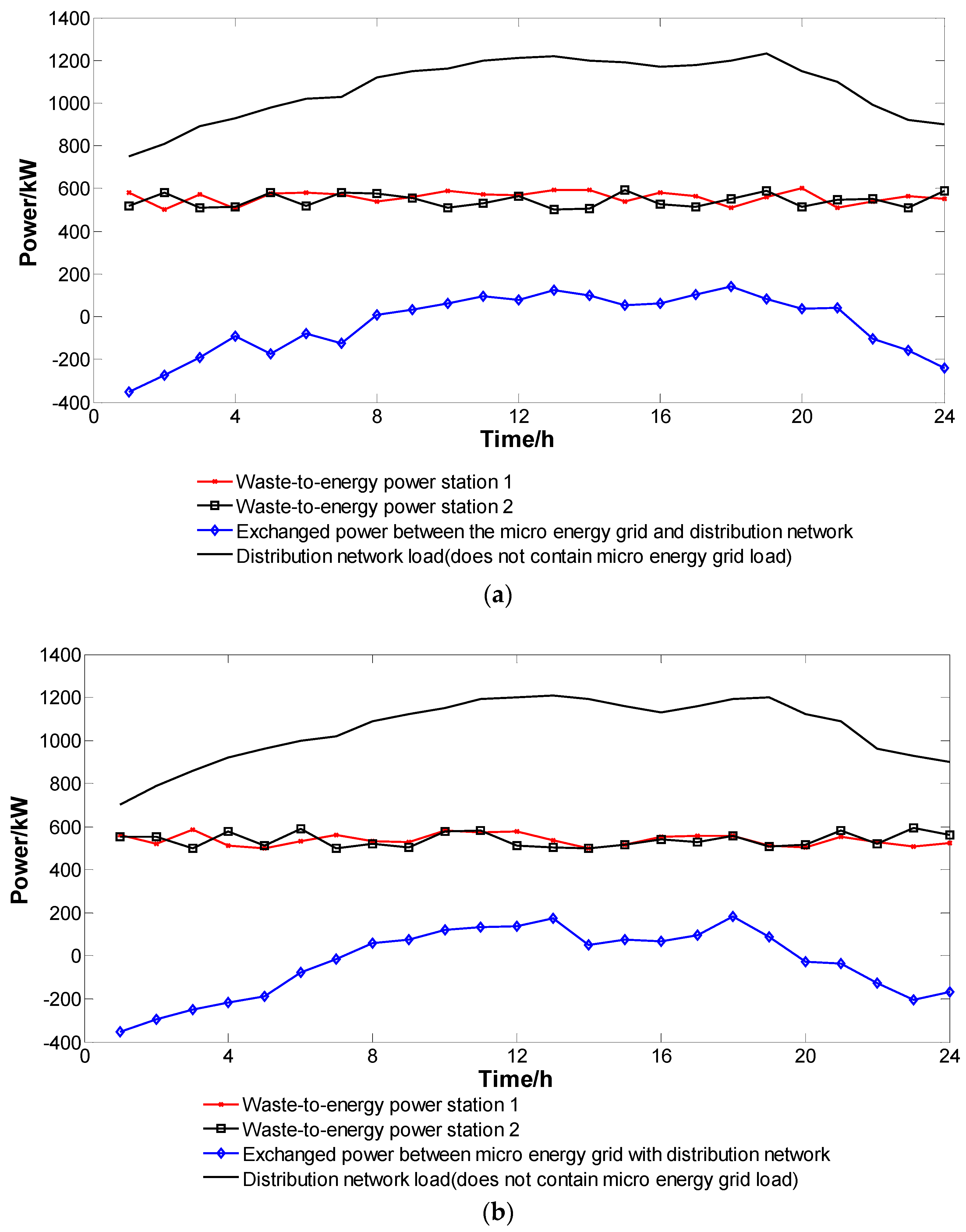
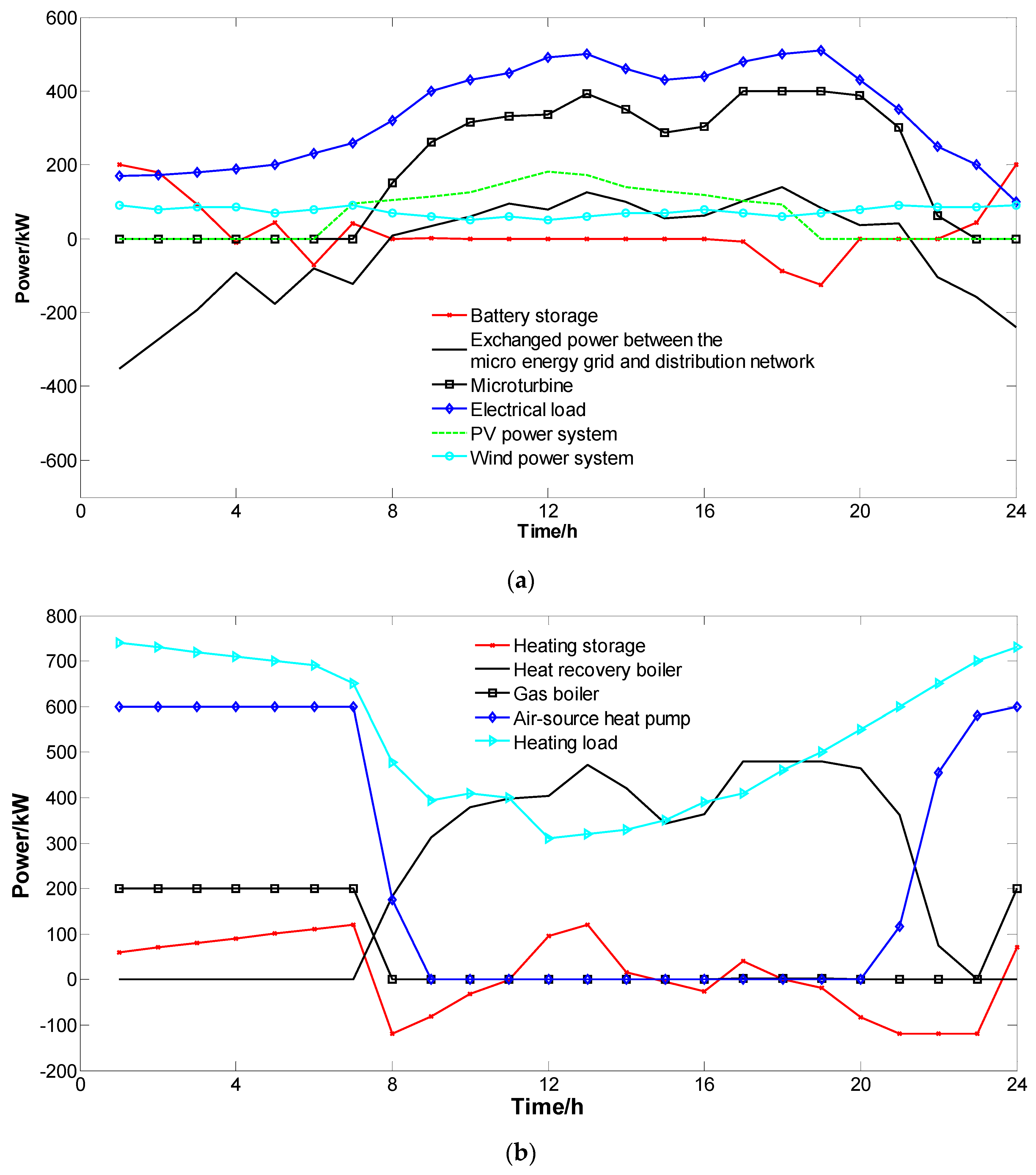
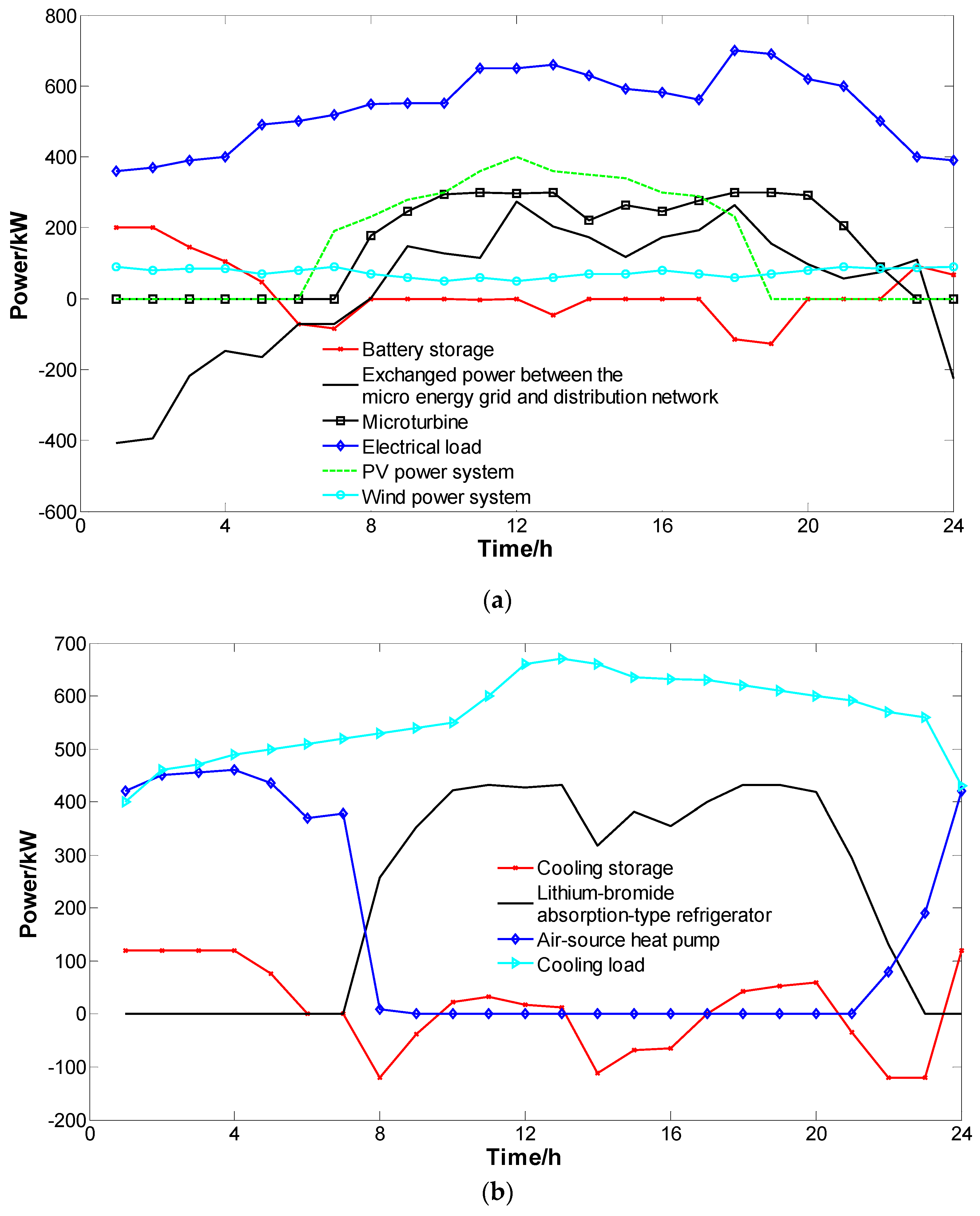
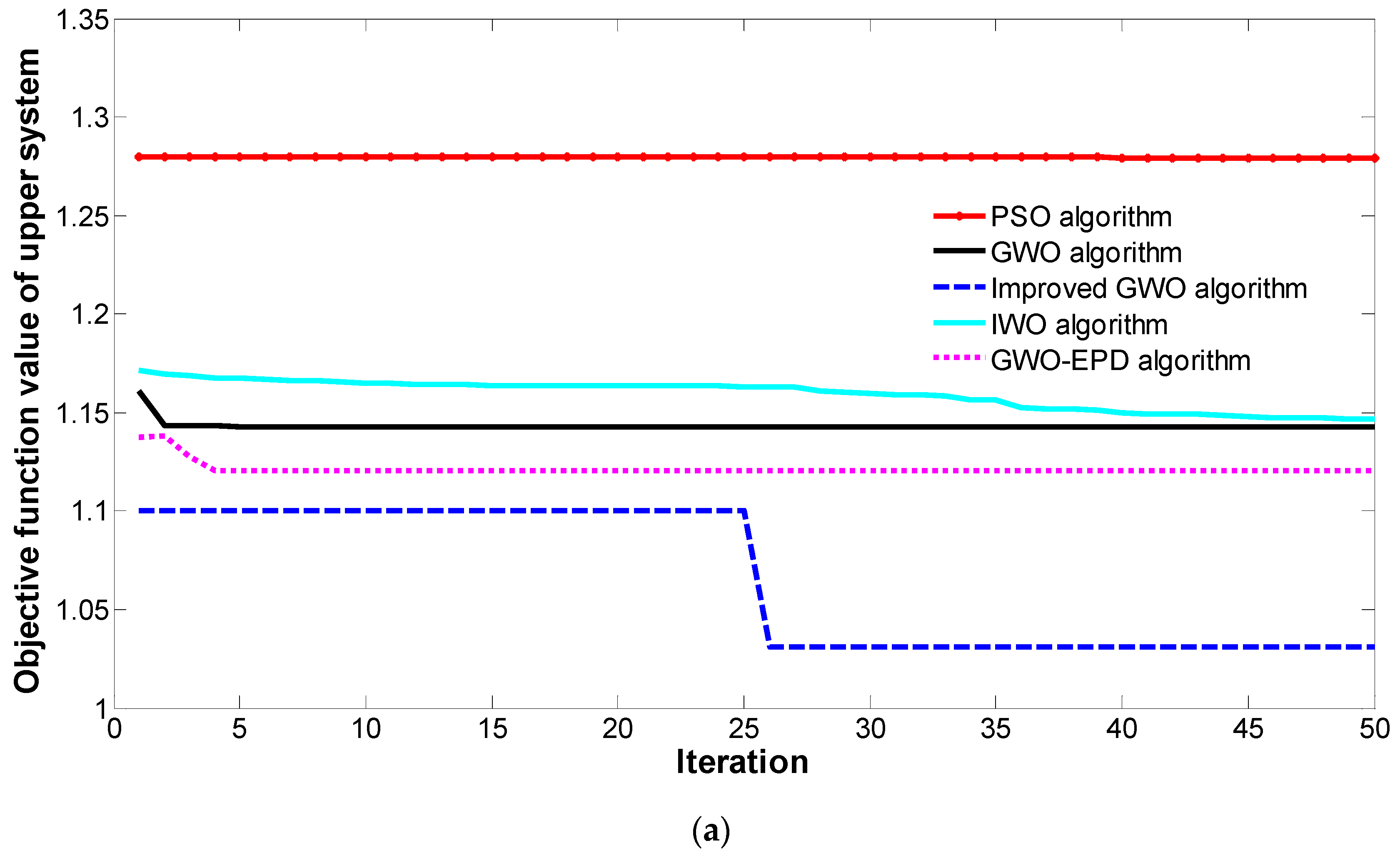
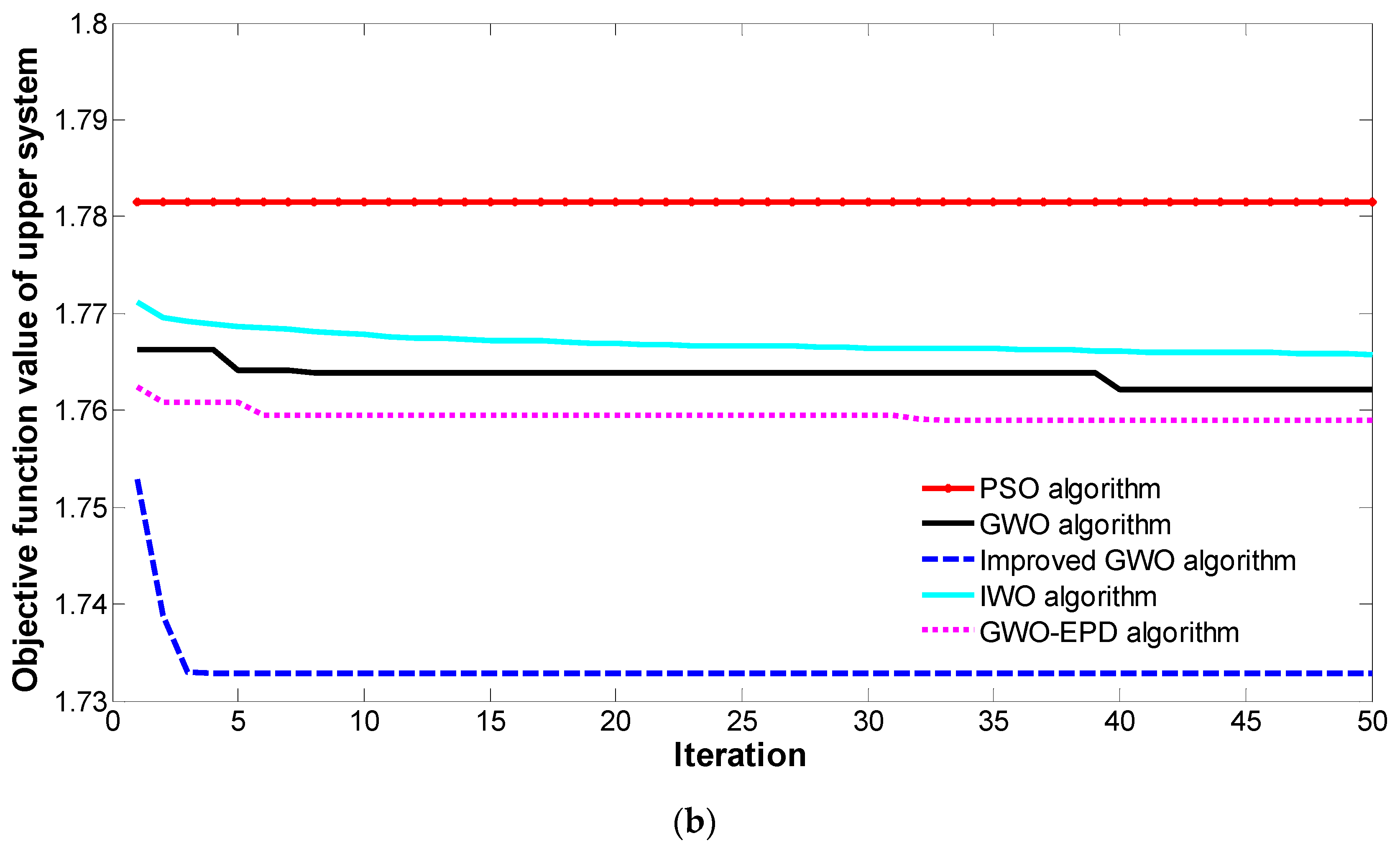
| Scale | Meaning |
|---|---|
| 1 | Comparing two factors, they are equally important. |
| 3 | Comparing two factors, one is slightly more important than the other. |
| 5 | Comparing two factors, one is more important than the other. |
| 7 | Comparing two factors, one is significantly more important than the other. |
| 9 | Comparing two factors, one is strongly more important than the other. |
| 2, 4, 6, 8 | The scale of compromise between two adjacent judgments. |
| Test Function | Search Scope |
|---|---|
| [−10, 10] | |
| [−1.28, 1.28] | |
| [−100, 100] | |
| [−5.12, 5.12] | |
| [−32, 32] | |
| [−600, 600] |
| Period | Time | Buying Electricity Price/(RMB·kW·h−1) | Selling Electricity Price/(RMB·kW·h−1) |
|---|---|---|---|
| Peak period | 08:00 a.m.–11:00 a.m., 06:00 p.m.–11:00 p.m. | 0.7590 | 0.65 |
| Flat period | 07:00 a.m.–08:00 a.m., 11:00 a.m.–06:00 p.m. | 0.5100 | |
| Valley period | 11:00 p.m.–12:00 a.m., 12:00 a.m.–07:00 a.m. | 0.2610 |
| Storage Equipment | Maximum Efficiency of Combined Electricity Heating and Cooling | Charged State of Combined Electricity Heating and Cooling | Lifespan/a | Capacity/(kW·h) | Initial Investment Cost/(RMB/kW) | Maintenance Cost/(RMB/kW·h) | ||
|---|---|---|---|---|---|---|---|---|
| Charging | Discharging | Maximum | Minimum | |||||
| Battery storage | 0.2 | 0.2 | 0.9 | 0.2 | 5 | 1000 | 1100 | 0.03 |
| heating and cooling storage tank | 0.2 | 0.2 | 0.9 | 0.1 | 10 | 600 | 1200 | 0.02 |
| Equipment | Parameter | Value | Equipment | Parameter | Value |
|---|---|---|---|---|---|
| Microturbine(four) | Maximum generated power/(kW·one−1) | 100 | Gas-fired boiler | Maximum input power/kW | 200 |
| Rated efficiency | 0.26 | Rated efficiency | 0.8 | ||
| Maintenance cost/(RMB/kW·h) | 0.03 | Maintenance cost/(RMB/kW·h) | 0.02 | ||
| Initial investment cost/(RMB/kW) | 5000 | Initial investment cost/(RMB/kW) | 2500 | ||
| Lifespan/a | 10 | Lifespan/a | 10 | ||
| Ramp speed/(kW/min) | Upper 30 Lower 20 | Ramp speed/(kW/min) | Upper 30 Lower 20 | ||
| Heat-recovery boiler | Maximum input power/kW | 480 | Air-source heat pump | Maximum input power/kW | 600 |
| Rated efficiency | 0.9 | Heating and cooling efficiency parameter | 3.7 | ||
| Maintenance cost/(RMB/kW·h) | 0.02 | Maintenance cost/(RMB/kW·h) | 0.02 | ||
| Initial investment cost/(RMB/kW) | 3000 | Initial investment cost/(RMB/kW) | 3900 | ||
| Lifespan/a | 10 | Lifespan/a | 10 | ||
| Photovoltaic (PV) system | Maximum generated power/kW | 300 | Wind-power system | Maximum generated power/kW | 100 |
| Maintenance cost/(RMB/kW·h) | 0.03 | Maintenance cost/(RMB/kW·h) | 0.03 | ||
| Initial investment cost/(RMB/kW) | 6500 | Initial investment cost/(RMB/kW) | 6300 | ||
| Lifespan/a | 20 | Lifespan/a | 20 | ||
| Exchanged power between the micro energy grid and the distribution network | Maximum exchanged power/kW | 500 | Lithium-bromide absorption-type refrigerator | Maximum input power/kW | 576 |
| Rated efficiency | 1.2 | ||||
| Maintenance cost/(RMB/kW·h) | 0.025 | ||||
| Initial investment cost/(RMB/kW) | 3000 | ||||
| Lifespan/a | 10 |
| Algorithm | Cost of the Distribution Network (Does Not Contain Micro Energy Grid)/RMB | Cost of the Micro Energy Grid/RMB | Total System Cost/RMB | |||
|---|---|---|---|---|---|---|
| Winter | Summer | Winter | Summer | Winter | Summer | |
| PSO algorithm | 1,126,004,317 | 39,809,957 | 94,318,029 | 3,292,247 | 1,220,322,346 | 43,102,204 |
| IWO algorithm | 750,401,055 | 39,040,023 | 71,295,926 | 3,273,691 | 821,696,981 | 42,313,714 |
| GWO algorithm | 741,777,648 | 38,852,914 | 68,603,822 | 3,266,733 | 810,381,470 | 42,134,740 |
| GWO-EPD algorithm | 740,359,725 | 38,717,692 | 65,104,632 | 3,253,778 | 805,464,357 | 41,971,470 |
| Improved GWO algorithm | 419,218,459 | 37,523,714 | 56,072,998 | 3,141,208 | 475,291,457 | 40,664,922 |
| Parameters | Weight of Total System Cost | Weight of Network‘s Active Power Loss | Standard Deviation of the Voltage Deviation | |||
|---|---|---|---|---|---|---|
| Minimum | Maximum | Minimum | Maximum | Minimum | Maximum | |
| Changes in weight | −0.1922 | 0.0463 | −0.0928 | 0.3266 | −0.0793 | 0.5894 |
| Weight sensitivity criterion | 0.3471 | 0.5856 | 0.2046 | 0.624 | 0.084 | 0.753 |
| Weight stable interval | 0.2385 | 0.4194 | 0.6687 | |||
© 2018 by the authors. Licensee MDPI, Basel, Switzerland. This article is an open access article distributed under the terms and conditions of the Creative Commons Attribution (CC BY) license (http://creativecommons.org/licenses/by/4.0/).
Share and Cite
Zhang, X.; Yang, J.; Wang, W.; Jing, T.; Zhang, M. Optimal Operation Analysis of the Distribution Network Comprising a Micro Energy Grid Based on an Improved Grey Wolf Optimization Algorithm. Appl. Sci. 2018, 8, 923. https://doi.org/10.3390/app8060923
Zhang X, Yang J, Wang W, Jing T, Zhang M. Optimal Operation Analysis of the Distribution Network Comprising a Micro Energy Grid Based on an Improved Grey Wolf Optimization Algorithm. Applied Sciences. 2018; 8(6):923. https://doi.org/10.3390/app8060923
Chicago/Turabian StyleZhang, Xin, Jianhua Yang, Weizhou Wang, Tianjun Jing, and Man Zhang. 2018. "Optimal Operation Analysis of the Distribution Network Comprising a Micro Energy Grid Based on an Improved Grey Wolf Optimization Algorithm" Applied Sciences 8, no. 6: 923. https://doi.org/10.3390/app8060923





